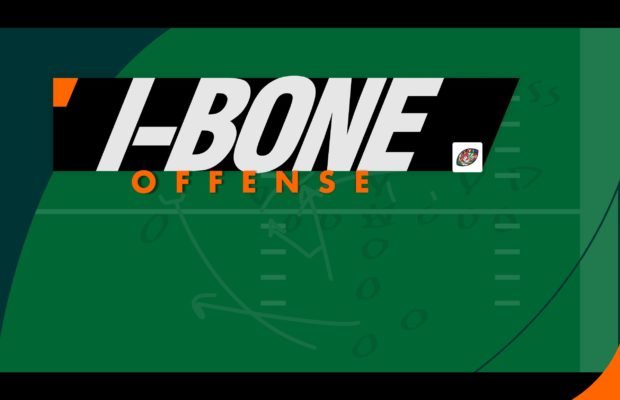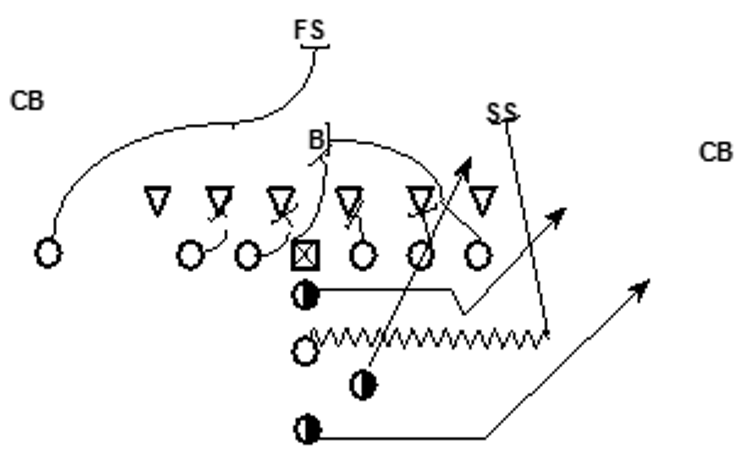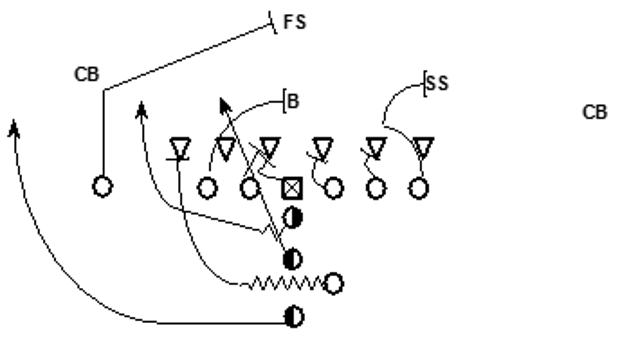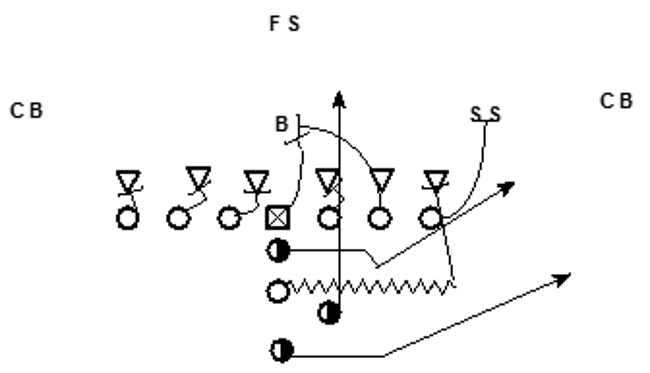Attacking Goal-Line and Short-Yardage Defenses With the I-Bone Offense

Every team, no matter how many long touchdowns it scores, eventually finds itself at the opponents goal line or in a short-yardage situation where getting the yards needed for a touchdown or first down can make the difference between winning and losing. Opponents usually go into a defense that is different than their base scheme in an attempt to prevent the offense from scoring or gaining a critical first down. This chapter examines how best to attack goal-line and short-yardage defenses.
Running the Triple Option Against Goal-Line Defenses
The best play to run against a goal-line or short-yardage defense in which the down linemen are tightly aligned next to each other, such as in the 6-1 defense, is the outside Houston Veer.
Most defensive coaches hate to defend against this play because a goal-line defense often will not have enough players to defend against all of the options. In addition, because of the proximity of the end zone, the defense cannot afford to employ certain tactics, such as a feathering defensive end, to try and string out the option. More often than not, the defender being optioned on the dive phase will tackle the diveback because he is the first threat to score, so this play usually is a quarterback keep.
The block of the tight end and playside tackle are critical to the success of this play. But the TE may have to block down onto the middle linebacker because the presence of defenders in both A gaps may limit the center’s ability to reach-block the MLB. To strengthen the blocking on this play, it is helpful to send the fullback in motion to a wing position. From there, he can block down on the second level and wall off the strong safety or other defenders pursuing from the backside. In addition, the split-end’s alignment should be adjusted inward so that he is closer to the backside tackle, which will facilitate his getting upfield more quickly to try and block the free safety. See Diagram 9-1 below.

Diagram 9-1
Running the I triple option to the backside by putting the halfback in short motion is another good play to run against a goal line defense that aligns the strong safety to the tight end side of the formation. Depending on how the Number 1 and 2 defenders are aligned respective to the center and playside guard, either the PSG or tackle should have a favorable blocking angle on the middle linebacker. If the play is run to the split-end side of the formation, the motioning HB also can load block the end man on the line of scrimmage to strengthen the threat of the quarterback keep and prevent that defender from penetrating the backfield and disrupting the option play. See Diagram 9-2.

Diagram 9-2
The inside Houston Veer can be an effective play against a goal-line defense, depending on how many linebackers the defense employs in the goal-line set and where they are aligned. Against a 6-1 alignment in which there is only one linebacker aligned over the center, the normal triple option blocking rules can be employed, with one recommended adjustment. The offense should have the tight end man-block Number 3 or else load-block him with a motioning fullback to prevent this defender from employing a jet or crash technique against the quarterback after he disengages from the dive option ride. In addition, if the defense puts six or more defenders on the line of scrimmage, running a double tight-end set is recommended to keep the backside down lineman from chasing the option down from behind. See Diagram 9-3.

Diagram 9-3
Excerpted from “Attacking Defenses With Football’s I-Bone Option Offense,” by Joey Lozano. Published by Coaches Choice Books and Video. For more information, see https://www.coacheschoice.com/p-3215-attacking-defenses-with-footballs-i-bone-option-offense.aspx